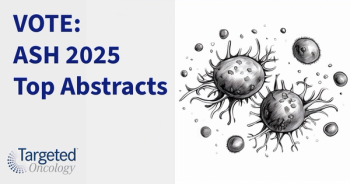
Durable Responses Achieved With Acalabrutinib in MCL
Durable responses were achieved with acalabrutinib therapy for patients with relapsed/refractory mantle cell lymphoma, with 40% still on treatment for more than 2 years, according to long-term follow-up findings presented at the 2018 ASH Annual Meeting.
Michael Wang, MD
Durable responses were achieved with acalabrutinib (Calquence) therapy for patients with relapsed/refractory mantle cell lymphoma (MCL), with 40% still on treatment for more than 2 years, according to long-term follow-up findings presented at the 2018 ASH Annual Meeting.
In the ACE-LY-004 study (NCT02213926), 49 of the 124 patients (40%) remain on treatment at a median follow-up of 26 months (range 0.3-35.1). The investigator-assessed overall response rate (ORR) was 81% (95% CI, 73-87). Also, 43% (95% CI, 34-52) of patients achieved a complete response (CR), while the median overall survival (OS) was not reached (NR).1
An analysis of minimum residual disease (MRD) using next generation sequencing (10-6) in 29 patients demonstrated that 8 achieved undetectable MRD in at least 1 blood sample tested (28%). All patients with MRD negativity had CRs.
Acalabrutinib was approved by the US Food and Drug Administration for the treatment of relapsed/refractory MCL based on clinical data published in 2017 that showed a high rate of durable responses and a favorable safety profile.2The data presented here followed patients until February 12, 2018.
“The responses relatively stayed the same [as the earlier published data] and the tolerability of this drug is amazing,” said lead author Michael Wang, MD, director of the Mantle Cells Lymphoma Program at MD Anderson Cancer Center, Houston. “This is a single drug with durable responses. The efficacy and toxicity profiles stand the test of time.”
The single-arm study enrolled 124 patients with relapsed/refractory MCL. Patients received oral acalabrutinib at 100 mg twice-daily in 28-day cycles until disease progression or unacceptable toxicity. Most patients were intermediate risk by simplified MCL International Prognostic Index scores (44%) and 8% had bulky lymph nodes (≥10 cm). Seventy-two percent had extranodal disease.
The median patient age was 68 years (range, 42-90), 80% were male, and 93% had an ECOG performance status of 0 or 1. The median number of prior treatments was 2 (range, 1-5) and 24% were refractory to their most recent prior treatment, which included stem cell transplant for 18% of patients. Those treated with a prior Bruton’s tyrosine kinase inhibitor were excluded from the trial. The most common prior therapy was rituximab (Rituxan) as a single-agent or in a combination regimen.
At the long-term follow-up, 40% or patients remain on acalabrutinib and 61% remain on study. Of the 60% who discontinued acalabrutinib, 44% did so because of disease progression, 8% due to an adverse event (AE), and 5% initiated subsequent anticancer therapy. The median relative dose intensity (ratio of actual to planned cumulative dose during drug exposure period) was 99%.
The 81% ORR at 26 months was identical to the 15-month ORR, and some patients who initially had a partial response converted to a CR at 26 months, noted Wang. The CR rate increased from 40% at 15 months to 43% at 26 months. The ORRs were consistent across prespecified subgroups based on tumor bulk, presence of refractory disease, and number/type of prior treatment.
The median duration of response (DOR) was 26.0 months (95% CI, 17.5-NR), and the 24-month DOR rate was 52.4% (95% CI, 41.5-62.2). The median progression-free survival (PFS) was 20.0 months (95% CI 16.5-27.7), and the 24-month PFS rate was 49% (95% CI, 40-58), The estimated 24-month OS rate was 72% (95% CI, 64-80).
Of the 29 patients who had samples available for MRD analysis, 17 had a second blood sample tested about 6 months after the first, including 5 of the 7 MRD-negative patients at the first assessment. “Four of the 5 had sustained MRD negativity, and the fifth had a borderline switch to MRD positive,” said Wang.
No new safety signals were observed with long-term follow-up, and there was no new onset of atrial fibrillation. The most frequent AEs any-grade AEs included headache (38%), diarrhea (36%), fatigue (28%), cough (22%) and myalgia (21%), most of which were grade 1/2. Grade 3/4 AEs in ≥5% included anemia (11%) and neutropenia (11%).
“The AE profile was largely consistent with earlier reporting,” Wang added. “The major thing is the lack of fatigue with long-term exposure and also the lack of major bleeding.”
Thirteen patients (10%) had 16 cardiac events, 4 of which were grade 3/4 (3%). Four patients had hypertension events (3%), 1 of which was grade 3. Bleeding events occurred in 33%, the most common being contusion (13%) and petechiae (9%). All bleeding events were grade 1/2 except for 3 grade 3 events. Grade 3/4 infections occurred in 15% of patients, most commonly pneumonia (6%).
Of the 43 deaths (35%) on study, 23% were due to progressive disease and 5% due to AEs; none were considered to be related to acalabrutinib. Deaths due to AEs included bilateral pulmonary embolism, critical aortic stenosis, myelodysplastic syndrome, pneumonia, suicide, and non-small cell lung cancer.
References:
- Wang M, Rule S, Zinzani PL, et al. Long-term follow-up of acalabrutinib monotherapy in patients with relapsed/refractory mantle cell lymphoma. Presented at: 2018 ASH Annual Meeting; Dec. 1-4, 2018; San Diego. Abstract 2876.
- Wang M, Rule S, Zinzani PL, et al. Acalabrutinib in relapsed or refractory mantle cell lymphoma (ACE-LY-004): a single-arm, multicentre, phase 2 trial.Lancet. 2017;391:659-67.









































